WordPress plugin pricing models are a notoriously complex issue. Read this blog for an insider insight to understand plugin pricing.

Understandably, plugin developers want to set a fair price for something they spent a great deal of time creating. On the other hand, customers are looking for the best value.
So, how do developers go about pricing their plugins?
July 2024 Offer – For a Limited Time Only:
Get WordPress 99+ Plugins Mega Bundle for 15% off! Don’t miss out!
Background on the Pricing Debate

Discussion around the best way to price plugins has amassed a great deal of attention within the WordPress community. It largely began when WordPress aficionado Chris Lema took to his blog to declare that WordPress Plugin Prices Are Too Low.
In the post, which garnered intense discussion in the comments section and even prompted others to post their own blogs reacting to his thoughts, Lema cites the amount of time plugins save as one of the biggest reasons prices should be higher.
Discussions such as this bring the plugin pricing debate into the limelight. They show plugin developers aren’t exactly sure what the “ideal” pricing model is, and highlight that consumers looking to purchase premium plugins are likely to run into some different, and sometimes confusing, pricing models.
In this post, we aim to help users get a better understanding on what’s on offer and why developers choose the models they do.
Our Survey
This topic is a complicated one, but it’s important for WordPress users and plugin developers alike. As a result, we decided to look at plugin pricing across the board in order to find out more about the most common strategies – and some of the more unusual ones.
So how did we do this?
We started by making a list of 15 of the top companies that make plugins for WordPress. This includes developers that offer a number of different plugins, as well as ones that concentrate solely on one plugin.
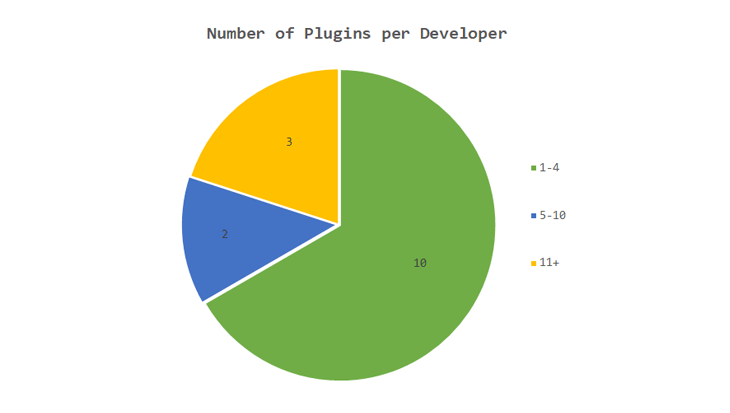
The ones that we focussed on (in alphabetical order) are:
- CreativeMinds (That’s us!)
- Fly Plugins
- iThemes
- MailPoet
- Pippin’s Plugins
- Relevanssi
- RocketGenius
- Search WP
- Soliloquy
- Sprout Invoices
- VFB Pro
- WMPUDEV
- WooCommerce
- WP Events Manager
- Yoast
Once we had the 15 in our sights, we scoured their websites to find more information about their pricing models and structures as well as the support they offer to customers.
Every website surveyed was vastly different. Some companies make their pricing clear and upfront from the first click, while others are less transparent about how customers can pay.
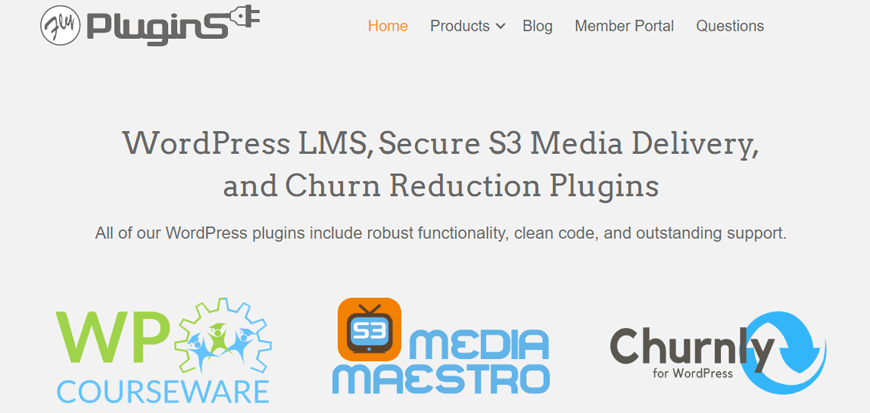
We’ll start by stating the facts, before taking a closer look at just some of the factors that influence plugin pricing models.
So, without further ado, here’s what we found:
The Average Price
Calculating the average price for a plugin is no easy task.
We found that typically developers offer more than one plugin. In fact, 40% of the companies we looked at have more than one plugin. Where this is the case, they don’t tend to offer the same price for each of their plugins. This made calculating the average price for a plugin somewhat difficult.
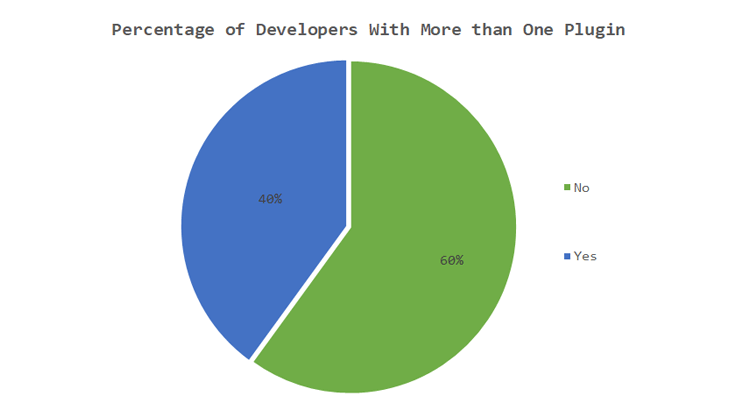
So, in order to aggregate data, we included only those who offer one plugin. Our data was collected in USD (with conversions carried out where needed) and excluding any temporary discounts or deals.
We found that the average price WordPress users can expect to pay is $138. While this may seem like a lot of money to spend on one plugin, prices for individual plugins can range from as little as $15 to upward of $200.
Packages that include multiple plugins, like the ones offered by iThemes and WMPUDEV, can range from $200 to more than $500.
The factors affecting these differences in price will be explored later on once we’ve delved further into the pricing models and structures on offer.
Popular Plugin Pricing Models
There are many different models plugin developers can use to sell their product. In 2013, Tom McFarlin highlighted the most popular ways of pricing plugins:
- Freemium: With the freemium model, developers offer free/premium (or called lite/pro) versions of a plugin. The idea is that getting users exposed to the plugin through the free version will cause a significant number of them to opt for the paid version.
- Transaction: Pay a one-time purchase fee for a plugin.
- Subscription: Pay for the plugin or support/upgrades for a certain period of time. This is most commonly monthly or yearly.
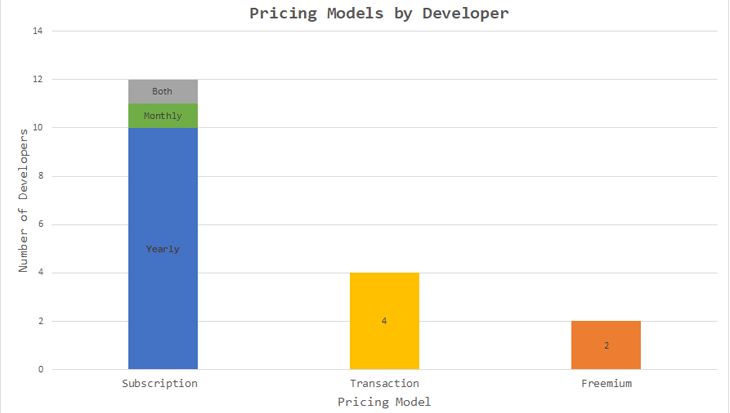
However, a lot has changed since McFarlin wrote in 2013, so we wanted to look at whether or not there’s been any changes in pricing models since then.
In our survey, we found that pricing models are largely the same as McFarlin outlined in his post. However, looking at the extent to which they are used provides interesting results.
We found that the most common pricing model is subscription. This was used in some form by 12 of the 15 developers surveyed, equating to 80%.
Of the 12 developers offering a subscription model, 16% offered users a monthly subscription for their plugins. However, a more popular method was a yearly subscription, with 91% opting for this.
4 of the 15 companies (26%) offered the transaction method, or some kind of one of fee for unlimited access to their plugins – including CreativeMinds.
However, we found that the freemium model was the least popular, with only 2 developers (13%) offering a free demo or ‘try before you buy’ deal.
The reason for this may be that freemium offerings are more useful for businesses that are just starting out, so that developers can establish their name and gain feedback. However, the businesses surveyed here are all established names, and so the freemium method is less beneficial in their case.
The yearly subscription model helps businesses sustain themselves by maintaining a profit from previously sold plugins. This means they can continue to provide support and updates and afford to work on the next new plugin.
Plugin Pricing Structures

Within the models outlined above, we also identified trends in the way customers can pay. We found three main structures – tiers, bundles, and the less common membership method.
Tiers
We found that the majority of developers (67%) offered a tiered structure to their pricing. This is where developers offer at least two different levels of pricing, depending on the needs of the customer.
The wording of categories varies from site to site, but the tiered method generally goes as follows:
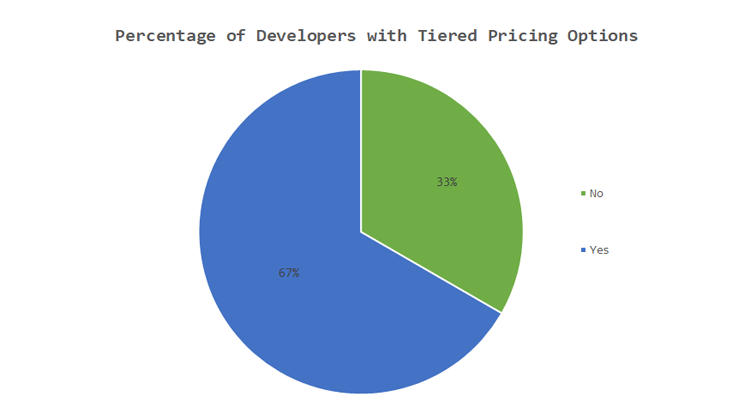
Developers offer one price for a Basic/Standard/Personal plugin. This typically comes with one or two site licenses. Users then have the option to pay more for extra licenses in bulk and receive a discount. This is the price for the Professional/Business/Agency version.
For the majority of plugins, the professional version offers all the same features, just with more licenses. For others, the difference between a basic and professional version isn’t just the number of licenses – offering premium level support and advanced features to match the higher price tag.
Many plugin companies also offer what is called a developer license. These are geared toward WordPress developers who want to use the plugin on many sites they work on. Developer options either offer unlimited installations or just a large number of licenses.
67% of companies we surveyed offer unlimited site licenses, though very few offer this as the sole option. The price for unlimited licenses ranges from $100-$500 depending on the developer, with an average price of $202. This number is significantly higher than the average price for one installation.
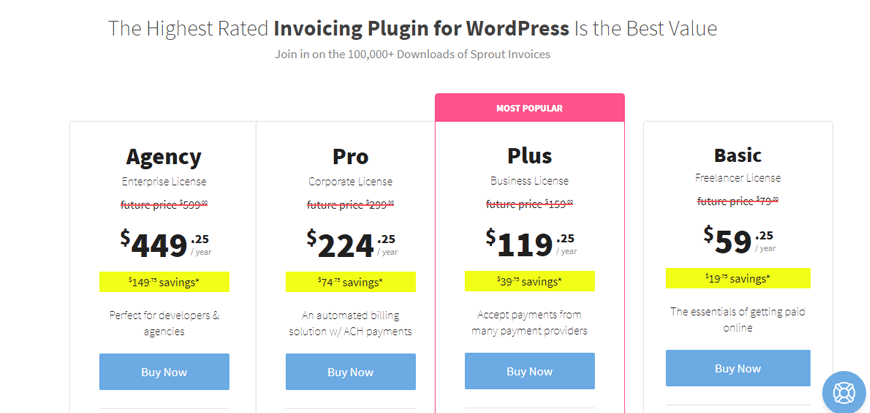
Plugin Suites and Bundles
Developers also sometimes offer plugin suites or ‘bundles’ to give customers access to more than one plugin.
However, plugin suites are fairly rare and most often available through sites with a large amount of plugins. Only 27% of companies surveyed offered some sort of plugin suite or bundle.
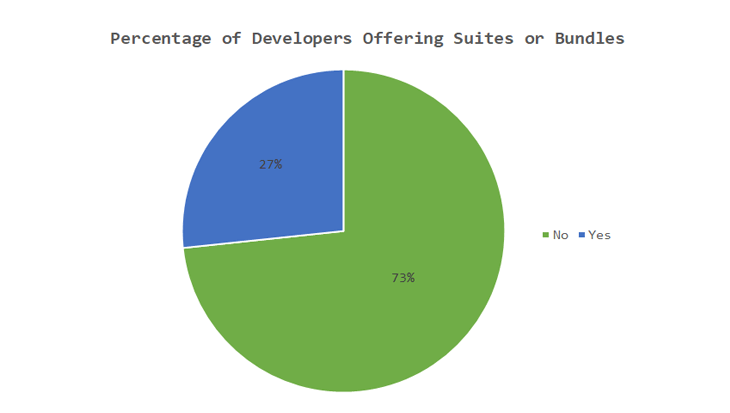
iThemes offers a suite of plugins as their main product. This includes favorites such as BackupBuddy and iThemes Security. The suite comes with unlimited site licenses but must be renewed yearly.
CreativeMinds also has a plugin suite, including all current plugins as well as future releases. This is the first and only plugin suite to include plugins that have not yet been developed.
Yoast offers specialized plugin bundles consisting of plugins that have related functions. For example, they have an SEO bundle that includes five different Yoast SEO plugins. This approach is helpful for customers looking for just one type of plugin.
Membership

Plugin developers are coming up with new, sustainable pricing models that stray from the usual pay-per-plugin model. One example is the membership model, where customers pay a certain amount to access all plugins from a developer as well as additional support.
Though this is still a rare model, WPMUDEV is an example of a developer offering membership.
People can become members, receiving a 7-day free trial, before paying monthly to have access to all of the company’s plugins. The cost is $49/month and members receive 24/7 support and a private messaging system.
While WPMUDEV used to offer an alternative for customers who just wanted certain plugins from their collection, this is no longer an option. Membership is the only way to gain access to any of WPMUDEV’s plugins, regardless of whether or not you would use all of them.
The company’s choice in pricing model has proved controversial in the past. When pricing options moved from yearly, quarterly, and monthly to only monthly, consumers were understandably upset as the price for new users rocketed from $420 to $1,118. However, this model certainly seems to be working for WPMUDEV, as they have over 800,000 members.
Support and Upgrade Models

When it comes to support and upgrades, the majority of developers use the same model. After the customer purchases a plugin, they receive support for one year. After the year, the license must be renewed for support to continue.
Soliloquy used to approach support in a different way. Their approach was to make users pay for “support tokens” in order to submit a support ticket. With the plugin purchase, users are given one token to get them started.
This new support system was borne from the idea that users who pay for support every year but don’t use it are punished. Also, “the 20% of users that create 80% of the tickets get an incredible deal at the expense of supporting other users and developing and improving the plugin”.
Soliloquy decided to try this model to reduce the time they spent answering the same users’ questions and increase the amount of time spent improving the plugin and creating others. Soliloquy has since changed their support system.
Another way developers price their support is by offering more support for higher license levels. For example, RocketGenius offers ‘priority support’ for its highest tier license for Gravity Forms. Similarly, Sprout Invoices gives premium support for their Enterprise License, primarily aimed at agencies.
Upgrades tend to operate the same way as support. Customers receive plugin upgrades for a year after purchasing the plugin and then must renew if they want to continue receiving the newest version.
Factors Affecting Pricing Models and Structures
When it comes to choosing a pricing model and structure, there are a number of factors influencing developer’s choices.
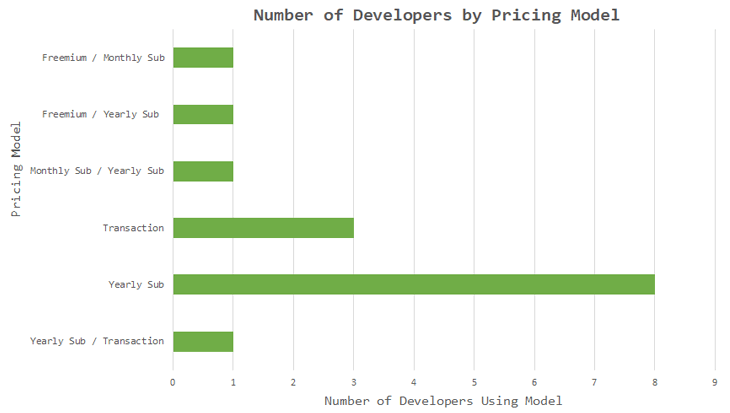
Plugin Scope
One large factor influence plugin pricing is the scope of the plugin, including features and work involved in maintaining it.
Marketing different plugins for the same price is rare because price depends on specifics such as what features the plugin has, the number of features, and how complex they are. This will determine how much time it takes to build the plugin, document it, and maintain it.
To illustrate this point, let’s look at a simplified example from a post by Press Up:
- The first plugin is one PHP file and took a few hours to write. It is simple and has one function.
- The second plugin transforms an entire website, took years to develop with the help of many people and has many complex features.

Which one costs more? The second plugin, of course. Logically, it should cost more for consumers because it provides greater value. A plugin like the second one can help make a mediocre site into a great one. It can save developers a large amount of time. The first plugin can’t do that.
Put simply, plugins aren’t priced the same because each and every plugin is different.
Different Users, Different Prices
One of the biggest factors influencing plugin pricing is what customers are willing to pay.
When we carried out research on how WordPress users choose plugins we found that a large amount of users (49%) are willing to pay more than $60 for a plugin.
WordPress users aren’t just looking for the cheapest option. They’re looking for the plugin that comes with the features they want and other determining factors like security, support, and ease of use.
An important point to remember when contemplating plugin pricing is there are different types of WordPress users looking for plugins.
Plugin developers understand this and have a range of prices based on various types of users. Out of the plugin developers surveyed, 73% have more than one pricing option for customers to choose from based on their needs. The most common number of pricing options is 3, with 40% of developers offering this.
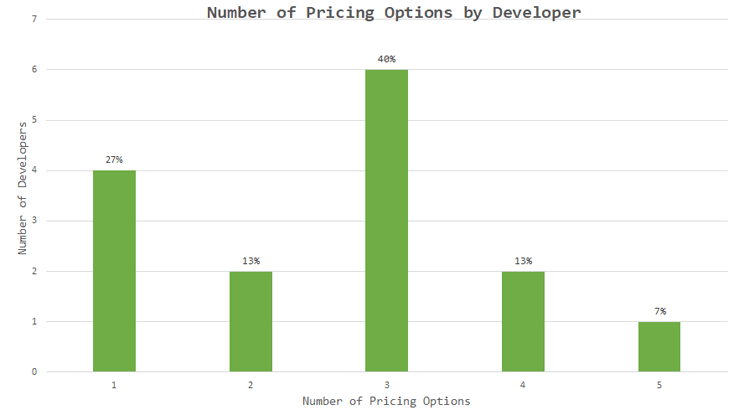
Offering several different plugin packages is important for appealing to a wide array of users, not just those who are able to spend the most cash.
A WordPress developer wanting to use a plugin on many sites will likely aim to purchase a developer license with unlimited site installations. The price for a plugin package with unlimited installations is often more than the price for one installation. In comparison, a blogger who owns a single site will not need unlimited licenses and will likely opt for the most basic (and cheapest) premium plugin with only one site installation.
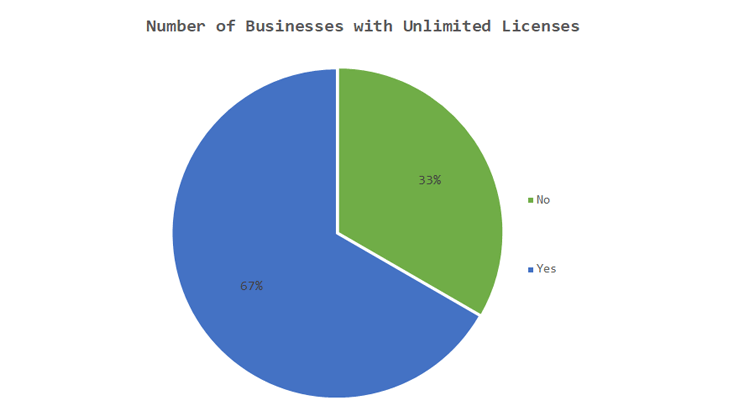
Different customers have different budgets based on business size, how long they’ve been around, amongst other factors, all of which contribute to how much they can afford to spend on a plugin.
Sustainability
Another factor that companies need to take into account when choosing a pricing model is sustainability.
For example, there is a stand-off between one off and recurring payments. As we’ve seen, most companies opt for a recurring payment option – where customers pay each month or year on a rolling basis.
However, an alternative to this is a lifetime license that doesn’t require renewal. Of the 15 developers we surveyed, only 2 (14%) offered this as an option. One of these is Relevanssi, which offers a “permanent” lifetime license with unlimited support and upgrades for $420.
One of the reasons that companies don’t tend to opt for one off lifetime licenses is that they often present more benefit to the customer than them. While a one-off payment reduces the hassle for customers having to renew every year, they don’t give companies a recurring income to grow on.
David Peralty, formerly of Gravity Forms, describes the problem with lifetime licenses perfectly:
“There are plugins selling lifetime licenses that will run out of interested buyers over a period of time, and they’ll lack any way to take fans of their software and turn them into a continuing revenue source. They also require constant infusion of new customers to maintain their bottom line, where subscription offers allow companies to predict income so that they can allocate expenses.”
Put simply, most plugin developers choose not to offer an option with a simple one off payment because this pricing model isn’t sustainable. As Justin Tadlock from the WordPress Tavern outlines:
“From a business perspective, companies need to keep existing customers while bringing in new buyers to continue maintaining, supporting, and building new features for the current product catalog. Companies also need growth to build new products. A recurring fee helps ease the burden of supporting and maintaining the existing products.”
Summary
If thinking about plugin pricing makes your head spin, you’re not alone! It can be a complicated matter and it’s influenced by many different factors.
Here’s an overview of the main facts we gathered from our research:
- The most common pricing model (used by 80% of developers) is the subscription model.
- Of those using the subscription model, the majority use a yearly subscription (91%). This is greatly favored over the monthly option, used by just 16%.
- The Freemium pricing model has dropped in popularity, with only 20% of developers offering this model.
- The majority of developers offer tiered pricing structures (63%).
- Most developers (73%) offer a license option with unlimited site installs.
- Support and upgrades tend to only be available for one year and users need to renew the license to receive more support and upgrades.

Plugin pricing models are far from static. Companies can change their pricing based on sales, company values, and the larger WordPress environment. Also, what works for one company may not work for another. The goal is to use a model that works for both customers and the developer.
As mentioned earlier, plugin pricing depends a great deal on the individual developer’s customer base. If most of the customers are big developers or companies, they can afford to spend more on plugins that will increase productivity. If a customer base consists more of everyday bloggers, they may not be willing or able to spend as much on a plugin.
Developers should aim to be clear about their pricing models and why they work. This helps in two different ways.
The first, you make it transparent what customers are paying for and why this is beneficial to them. It wasn’t always easy to find clear information on pricing on some of the websites surveyed here, which can be understandably frustrating for potential customers.
Secondly, being upfront about pricing can alleviate customers’ fears if and when developers change their pricing models and options – which they have every right to do. When customers are accustomed to one price, it can be jarring transition to another, so total transparency and honesty with customers is imperative.
On the flipside of the argument, consumers should always make sure to do their research before making a purchase. As we’ve found, it’s not always straightforward, but it helps to make sure you’re getting exactly what you need for a suitable price for your needs.
In the future, we may see plugin developers experiment with new pricing models. Only time will tell!
In the meantime, make sure you check out our CreativeMinds blog regularly. We keep you updated on the latest in WordPress as we as the wider web development world.


